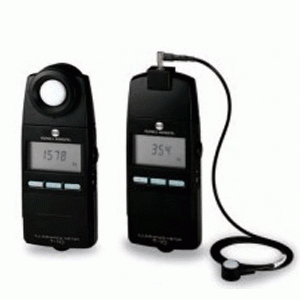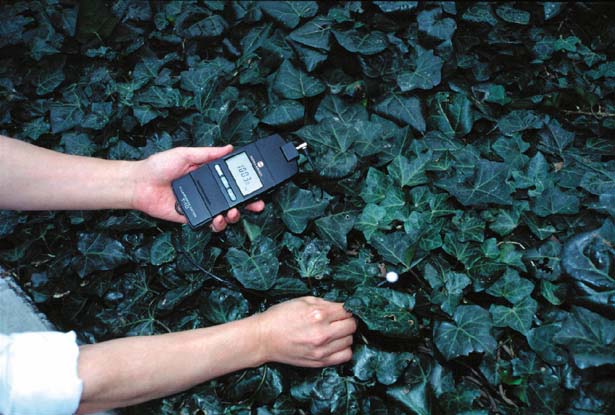 |
T-10/T-10M Illuminance Meters
Brand: KONICA MINOLTA
Made in Japan

The latest generation of Konica Minolta lux meters, the T-10, replaces the globally successful models of the T-1 series. The small, easy-to-use handheld meters are capable of measuring intermittent light sources, can be connected to each other to form multi-point units and are easily controlled with a PC. They have an extremely large measuring range of 0.01 to 299,000 lx with automatic range switching and a large, backlit LCD. All this with Konica Minolta's renowned high level of precision in a small, compact design.
Konica Minolta lux meters are used whenever brightness and the quantity of ambient light must be measured. Even the measurement of average values and illumination is possible. Examples of their use include the measurement of workplace and street illumination, the production of lamps as well as architectural, forestry, and agricultural applications. Deployment in hard-to-reach spaces and under water are possible, just as the metering of very large surfaces and projectors (ANSI lumens) by serial connection of several receptor heads. Metered values can also be visualized graphically and even fully automated by using the PC software.
As the names implies, lux meters measure lux (lx). That is the unit of illumination strength E, the light striking a certain location or the lumens (F) illuminating a certain surface (A):
E=Φ/A
In nature, luminance ranges from about 0.01 lx on a dark night of a new moon to about 100,000 lx on a hot summer day. Workplace illumination is normally around 1000 lx, many standards specify minimum values for the workplace. In some countries, the unit foot candles (fcd) is also used to denote illuminance. Of course, the T-10 will also display these values when desired. 1 fcd = 1 lm/ft2 = 10.764 lx
The T-10 series of lux meters can also monitor the integrated illuminance for up to 9999 hours and then determine the exposure H in lux hours (lxh). That is the measurement for the amount of light that falls onto a certain surface within a certain time (t), for example how much light a plant receives throughout a day:
H = E · t
With the ability to connect up to 30 receptor heads in series, the T-10 series can be built into a system for the measurement of ANSI lumens of projectors. The unit lumen (lm) designates the light energy (F) emitted by the projector. It is measured indirectly over light striking a certain surface using 9 receptor heads.
The general purpose unit for most applications. It is based on the same base unit common to all models of the T-10 series with operating panel, analysis unit and display and a removable standard receptor head. This modular concept allows the combination of various receptor heads and the expansion of the unit for adaptation to your measurement tasks.
All models of the T-10 series allow a variety of possibilities for measurement and analysis that leave nothing to be desired. The most important operational functions are accessed using three large buttons. An additional operating panel for less commonly used features is found under a sliding cover. That way, you are not distracted by additional operating elements during everyday work. A large, backlit liquid crystal display shows the measurement values; the illumination is automatically switched on as soon as it gets too dark. The T-10 models offer the following possibilities for analysis:
Other features facilitate daily use of the T-10 even more:
One of the special characteristics of the T-10 series is the ability to connect multiple receptor heads through a serial port. This allows measurements to be taken at several points simultaneously without having to move the instrument. That way, large areas such as movie screens, can be measured easily. With the help of the T-A30 Software you can measure the ANSI lumens of projectors for example.
Up to 30 receptor heads can be connected at once and the measurement values can be called up with the base unit. The individual receptor heads are connected with a common LAN cable (10BASE-T) that can be up to 100 metres long. The various receptor heads are separated from each other and from the evaluation unit.
Multi-point measuring becomes very easy with the T-A30 software. The software also graphically displays the system and allows the simultaneous display of all measurement values.
Spectral luminous efficiency V(l) defines the human eye and instruments should match this spectral response. The chart shows the T-10's remarkable alignment to this standard curve (f1 (CIE) within 8%). With discontinuous emitters, even higher accuracy can be achieved with the colour correction factor. The standard Konica Minolta calibration is performed to standard illuminant A.
The diffuser in front of the high-grade silicon photo diode is used for the accurate spatial evaluation of the light being measured. The ideal condition is cosine-shaped valuation over the wave angle; the deviation from this is a measure of accuracy. Also in such case the T-10 shows its strengths. The deviation becomes larger only at very high, nearly irrelevant wave angles.
Light wave angle Maximum cosine error
10° ± 1%
20° ± 1.5%
30° ± 2%
40° ± 3%
50° ± 4%
60° ± 5%
70° ± 8%
80° ± 20%
The instrument space is tight. With a receptor head of only 16mm diameter (14 mm diameter measurement area) and a 1 metre long lead, you can measure even hard-to-reach and small spots. The receptor head of the T-10M can be combined into multi-measurement systems with the normal receptor head of the T-10. All other features are identical to the basic model T-10.
PC linking and continuous storage using a recorder
Digital output: An RS-232C terminal supports direct connection to a PC.
Analog output: When connected to a recorder, illuminance values can be stored in a continuous fashion.
Highly-portable, handheld design capable of measurements in a wide range of luminance conditions. Flareless SLR (single-lens-reflex) optical system for high-accuracy measurements. Acceptance angle of 1/3° supports measurement of small target areas.
Measurement of the luminance of CRTs, LED, and ELs.
Measurement of road and tunnel brightness
Measurement of railway system signals
Measurement of road and airport signals
Measurement of illumination and outdoor signs
| Model | Illuminance meter T-10 <standard receptor head> | Illuminance meter T-10M <mini receptor head> |
|---|---|---|
| Type | Multi-function digital illuminance meter with detachable receptor head | |
| Receptor | Silicon photocell | |
| Relative Spectral Response* | Within 8% (f1´) of the CIE spectral luminous efficiency V (λ) | |
| Cosine Correction Characteristics | Within ±1% at 10° ; Within ±2% at 30° ; Within ±6% at 50° ; Within ±7% at 60° ; Within ±25% at 80° | |
| Illuminance units | Lux (lx) or foot candles (fcd) (switchable) | |
| Measuring range | Auto range (manual 5 range at the time of analog output) | |
| Measuring function | Illuminance(lx). illuminance difference(lx). illuminance ratio(%). integrated illuminance(lx·h). integration time(h). average illuminance(lx). | |
| Measuring range | Illuminance ··· 0.01 to 299,900 lx 0.001 to 29,990 fcd | |
| Integrated illuminance ··· 0.01 to 999,900 × 103 lx·h 0.001 to 99,990 × 103 fcd·h / 0.001 to 9999 h | ||
| User calibration function | CCF(Color Correction Factor) setting function | |
| Accuracy | ±2% ±1digit of displayed value (based on Konica Minolta standard) | |
| Temperature/humidity drift | Within ±3% ±1digit (of value displayed at 20°C/68°F ) within operating temperature/humidity range | |
| Digital output | RS-232C | |
| Analog output | 1mV/digit,3V at maximum reading; Output impedance: 10KΩ; 90% response time: FAST setting: 1ms, SLOW setting: 1s | |
| Display | 3 or 4 Significant-digit LCD with back-light illumination | |
| Operating temperature /humidity range | -10 to 40°C, relative humidity 85% or less (at 35°C) with no condensation | |
| Storage temperature /humidity range | -20 to 55°C, relative humidity 85% or less (at 35°C) with no condensation | |
| Power source | 2 AA-size batteries / AC adapter (optional) | |
| Battery life | 72 hours or longer (when alkaline batteries are used) in continuous measurement | |
| Dimensions | 69 ×174 × 35 mm (2-6/16×6-14/16×1-7/16 in.) | Main body : 69 × 161.5 ×30 mm (2-6/16×6-6/16×1-3/16 in.) Receptor : Φ16.5 × 12.5 (Φ11/16 × 1/2 in.) Cord length : 1m ( 3.3 in.) |
| Weight | 200g (7.0 oz.) without battery | 205g (7.2 oz.) without battery |
| Standard accessories | Φ3.5mm(Φ1/8 in.) subminiature plug for analog output ; Receptor cap ; Neck strap ; Case ; Battery | Φ3.5mm(Φ1/8 in.) subminiature plug for analog output ; Neck strap ; Case ; Battery |
| Optional accessories | Receptor head ; Adapter for Multi-point ; AC Adapter ; Data processing software | |
Specifications are subject to change without notice.
| * | Equivalent to 2% specified for T-1 series. 8% CIE(f1'),new JIS(1993) 2% old JIS |
|---|
About Us Contact Us Focus on Color Global Agents Site Map
Link:colorimeter Color Assessment Cabinets pecolor iQstest spectrophotometer
© 1998~2025 ColorController, Incorporated. All Rights Reserved.